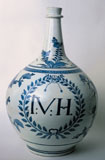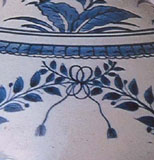- Museum Accession No.: EA1978.2635
- Catalogue No.: 116
- Object type: Gallipot
- Kiln/Location: Blue-and-white, Arita
- Period/Date: c. 1700
- Dimensions: H. 53.0 cm
- Provenance: Reitlinger gift
- Description: Gallipot. Single flange below straight rim. Underglaze blue decoration of chrysanthemum and peony sprays cover body between line at foot and narrow band of gadroons and double line at base of neck. On neck, flowering plants. Double line encircles foot.
This bottle was smashed during the disastrous fire in Gerald Reitlingers house, and those pieces retrieved from the ash have been reconstructed. Bottles of this shape, with the flange below the neck to facilitate the tying-on of a cloth cover, and a bulbous body were, for some reason, singled out by Volker, 1954, as 'gallipots'. Volker translated several different Dutch words as 'gallipot', included are fleskens, potjens, zalffpotten, conserfpotten, and cleijne fleskens (bottles, pots, salve pots, conserve pots and small bottles), which clearly mean a whole series of different shapes. Unfortunately, the name has stuck. We use it here solely to indicate this particular shape. Gallipots (this shape) vary considerably in size, from this large size to the small version and are also known in enamels, white only (no. 278) and hence also in 'Dutch decorated' (no. 281). Many examples, but by no means all, bear initials or monograms, which appear to relate to known individuals, most of whom have some connection to the Dutch East India Company. One bottle is known with a full name: Ds:Vandr:Hof. (Porcelain for Palaces, 1990, no. 40). In this case, the initials must refer to Joan van Hoorn, who, after a long career in the East, was Governor-General in Batavia from 1704-09. For another example bearing these initials, see Sheurleer, 1973(a), pl. 127. For a discussion of the initials found on these bottles, see Jorg, 1992, who has identified some thirty-odd examples.
- Exhibited:
- Similar Example:
- Illustrated:
|
Main View
|




